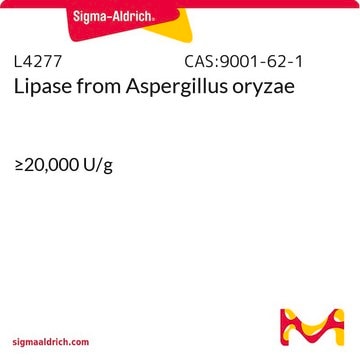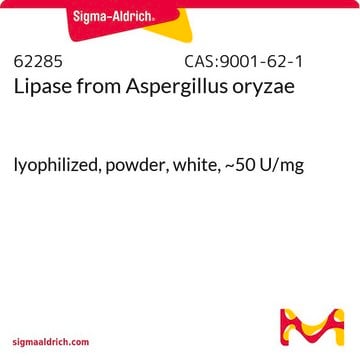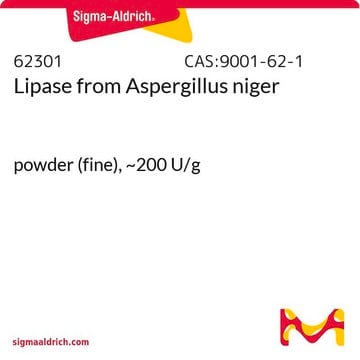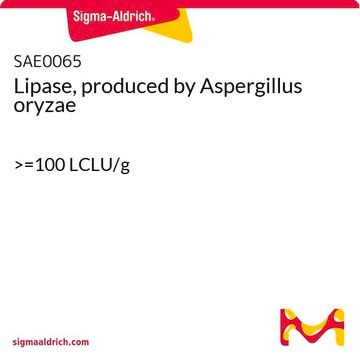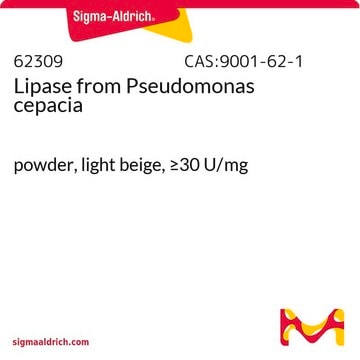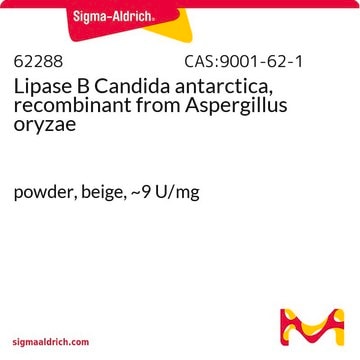L0777
Lipase from Aspergillus oryzae
solution, ≥100,000 U/g, white, beige
Synonyme(s) :
AOL, Lipolase 100L
About This Item
Produits recommandés
Source biologique
Aspergillus sp. (Aspergillus oryzae)
Forme
solution
Activité spécifique
≥100,000 U/g
Conditions de stockage
(Tightly closed. Dry)
Technique(s)
cell based assay: suitable
Couleur
beige
white
Température de stockage
2-8°C
InChI
1S/C11H9N3O2.Na/c15-8-4-5-9(10(16)7-8)13-14-11-3-1-2-6-12-11;/h1-7,16H,(H,12,14);/q;+1/b13-9-;
Clé InChI
QWZUIMCIEOCSJF-CHHCPSLASA-N
Vous recherchez des produits similaires ? Visite Guide de comparaison des produits
Description générale
Lipase is derived from Aspergillus oryzae by ammonium sulfate precipitation and chromatography.Lipases or triacylglycerol acyl hydrolases are a group of hydrolase enzymes that are usually found in humans and animals with monogastric stomachs. Lipase enzymes are generally formed in the pancreas and stomach where they aid in fat and lipids digestion.(2)
Application
- as a control enzyme in activity assays
- as a component in lipolase stock solution for the hydrolysis experiments
- to incubate scaffolds for lipase-accelerated degradation experiments
- as the lipolytic enzyme standard to detect lipolytic enzymatic activity via chromogenic agar plates and zymography
Actions biochimiques/physiologiques
Notes préparatoires
Informations légales
Anticorps
Enzyme
Produit(s) apparenté(s)
Substrat
Mention d'avertissement
Danger
Mentions de danger
Conseils de prudence
Classification des risques
Resp. Sens. 1
Code de la classe de stockage
11 - Combustible Solids
Classe de danger pour l'eau (WGK)
WGK 1
Point d'éclair (°F)
Not applicable
Point d'éclair (°C)
Not applicable
Équipement de protection individuelle
Eyeshields, Gloves, type N95 (US)
Certificats d'analyse (COA)
Recherchez un Certificats d'analyse (COA) en saisissant le numéro de lot du produit. Les numéros de lot figurent sur l'étiquette du produit après les mots "Lot" ou "Batch".
Déjà en possession de ce produit ?
Retrouvez la documentation relative aux produits que vous avez récemment achetés dans la Bibliothèque de documents.
Les clients ont également consulté
Notre équipe de scientifiques dispose d'une expérience dans tous les secteurs de la recherche, notamment en sciences de la vie, science des matériaux, synthèse chimique, chromatographie, analyse et dans de nombreux autres domaines..
Contacter notre Service technique